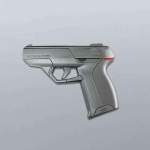Sooner or later I knew that Tim Wheeler, who runs a blog called Doctors for Responsible Gun Ownership, would come out and say something that reveals how far away he is from thinking like a serious physician. Or thinking like any kind of physician, for that matter. Since he started his so-called organization, which is basically just a blog, he has spent his time promoting one stupid and/or senseless notion for the gun industry after another stupid and/or senseless notion. From denying that physicians should question patients about guns, to advocating that physicians should hand out gun safety information that has never been reviewed by the medical academies, Wheeler pushes out opinions that pander to the lowest common mental denominator and misrepresent the role of doctors in dealing with health issues, guns or no guns.
Wheeler has now trained his sights on a situation in New Jersey where the legislature is thinking of amending a ‘smart gun’ law that was passed in 2002 but has never been implemented because no manufacturer could deliver a smart-gun product that both worked and was made available for retail sale. A brief attempt was made to sell one of these models in California, but the gun shop in question quickly removed the produce from its shelves when local gun nuts threatened a boycott of the store or worse.
 Wheeler refers to smart-gun technology as a “sweeping infringement” of the 2nd Amendment, a judgement obviously based on his expertise on the area of Constitutional law. If he would bother to actually read the 2008 Heller decision, he might notice that Scalia explicitly states that “nothing in our opinion should be taken to cast doubt on … laws imposing conditions and qualifications on the commercial sale of arms.” [p. 54] Notice the phrase, ‘commercial sale of arms,’ which even a jerk like Wheeler must know means that the government can decide what types of guns can and cannot be sold.
Wheeler refers to smart-gun technology as a “sweeping infringement” of the 2nd Amendment, a judgement obviously based on his expertise on the area of Constitutional law. If he would bother to actually read the 2008 Heller decision, he might notice that Scalia explicitly states that “nothing in our opinion should be taken to cast doubt on … laws imposing conditions and qualifications on the commercial sale of arms.” [p. 54] Notice the phrase, ‘commercial sale of arms,’ which even a jerk like Wheeler must know means that the government can decide what types of guns can and cannot be sold.
Smart guns were first hyped during the Clinton administration when the government awarded R&D grants to various inventors and entrepreneurs to develop new gun-safety technologies. You can get a very complete overview of the history and development of smart-gun products by reading a report published by the Department of Justice in 2013. The report brought together representatives of federal agencies and test labs, law enforcement bodies, technology institutes, public health researchers, and was discussed with staff from Smith & Wesson, Colt, FN and Ruger, among others.
If Wheeler read the report, perhaps he would have noticed right up front that the primary group of users for whom such technology is being developed is “people responsible for public safety (i.e., law enforcement personnel.)” [P. 8] I think that Wheeler only blogs about issues, like Heller, for which he hasn’t read the relevant texts, but why should a physician depend on anything other than his own opinions, correct?
Wheeler not only believes that smart-gun technology represents an ‘infringement’ on the 2nd Amendment, but worse, is a solution in search of a non-existent problem; i.e., accidental deaths of children from firearm misuse. He refers to these deaths as “miniscule,” claiming a “few dozen” lives each year. In fact, more than 75 children under the age of 18 died from accidental shootings in 2013, and more than 560 were treated for gunshot wounds.
But worse than understating the numbers is what this says about Wheler’s approach to medicine. Let me break the news to him gently: physicians don’t define a medical problem by how many patients present a particular symptom during an exam. The role of the physician, according to the Hippocratic Oath, is to reduce harm. And this applies to every single patient, whether the harm comes from something which is nearly universal, or is something that a physician might see only once.
Wheeler’s attempt to make readers believe that the severity of a problem is in any way based on its frequency is a conscious misstatement of the role of the physician and shows him to be the crackpot and gun industry mouthpiece that he really is.

Recent Comments